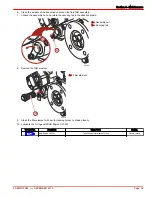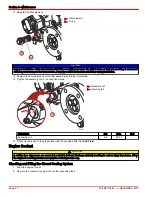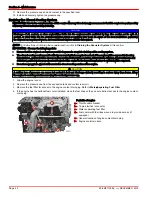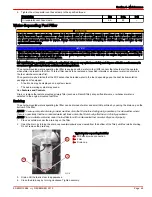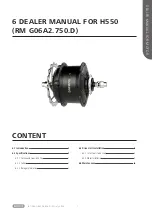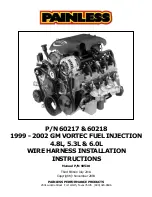
Section 4 - Maintenance
90-8M0113986
eng
DECEMBER 2015
Page 53
b. Start the engine and allow the seawater system to fill and the engine to reach normal operating temperature.
c. Run the engine at a fast idle between 600 and 1400 RPM. Monitor engine temperature to confirm proper operation of
the cooling system.
d. Inspect the seawater system for leaks maintaining a fast idle engine speed between 600 and 1400 RPM.
e. Tag the keys, record the service in the maintenance log, or otherwise make note that a proper operational inspection
of the seawater system must be performed before returning the boat to service.
9. If the boat is in the water, perform an operational inspection of the seawater cooling system.
a. Open the seacock, if equipped, or remove the plug and reconnect the seawater inlet hose.
b. Start the engine and allow the seawater system to be filled and the engine to reach normal operating temperature.
c. Check the seawater cooling system for leaks within an RPM range of 600 to 1400 RPM.
d. Carefully monitor the engine operating temperature to ensure that it remains in normal operational range and that the
seawater cooling system is functioning properly.
Engine Seawater Pump Inspection
IMPORTANT: Mercury strongly recommends that this service be performed by a Mercury Diesel authorized repair facility.
Remove and inspect the engine seawater pump at the interval specified in the
Maintenance Schedule
. See your Mercury
Diesel authorized repair facility.
Corrosion Protection
General Information
Whenever two or more dissimilar metals (such as those found on this power package) are submerged in a conductive solution
such as saltwater, polluted water, or water with a high mineral content, a chemical reaction takes place causing electrical
current to flow between metals. The electrical current flow causes the metal that is most chemically active, or anodic, to erode.
This erosion is known as
galvanic corrosion
and, if it is not controlled, it will eventually cause the need for replacement of power
package components exposed to water.
To help control the effects of galvanic corrosion, Mercury power packages come with several sacrificial anodes and other
corrosion protection devices. For a more comprehensive explanation of corrosion and corrosion protection refer to the
Marine
Corrosion Protection Guide
.
IMPORTANT: Replace sacrificial anodes if eroded 50% or more. Mercury strongly recommends avoiding the use of anodes
from other manufacturers. Refer to your Mercury Diesel authorized repair facility for additional information.
Engine Corrosion Protection Components
The engine is equipped with a sacrificial anode located in the end cover of the engine aftercooler to assist in protecting the
engine and the seawater cooling system from corrosion.
Removal
1. Allow the engine to cool.
NOTICE
Failure to close the seawater inlet or seacock when removing or replacing the anode plugs can lead to water damage. Close
the seacock or remove and plug the seawater inlet hose to prevent water from entering the anode plug holes.
2. With the engine off, close the seacock, if equipped, or remove and plug the seawater inlet hose.
3. Drain the seawater system. Refer to
Draining the Seawater System
.
Summary of Contents for 92-8M0069603
Page 2: ......
Page 8: ...Page iv 90 8M0113986 eng DECEMBER 2015 ...
Page 68: ...Section 4 Maintenance Notes Page 60 90 8M0113986 eng DECEMBER 2015 ...
Page 84: ......

